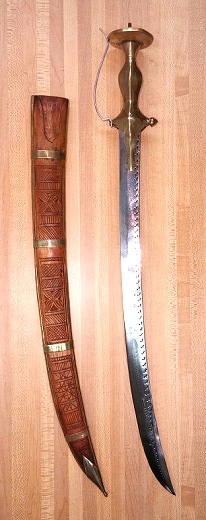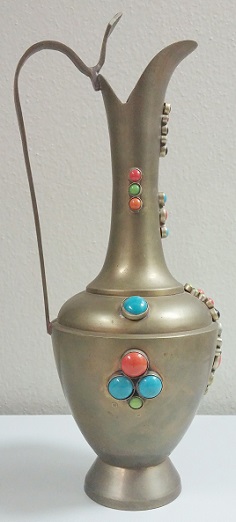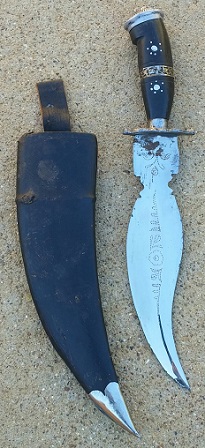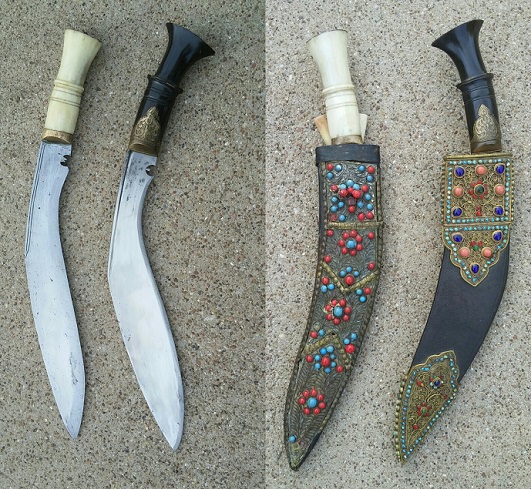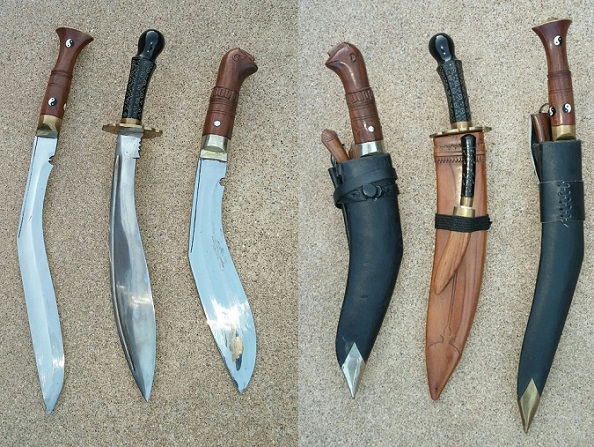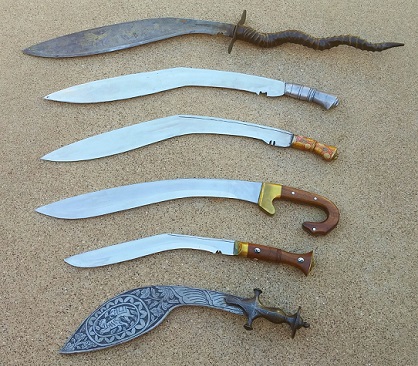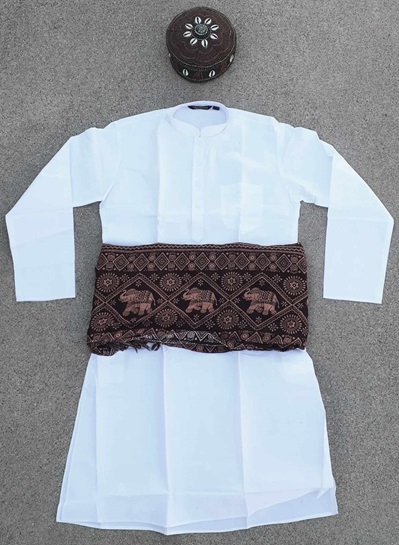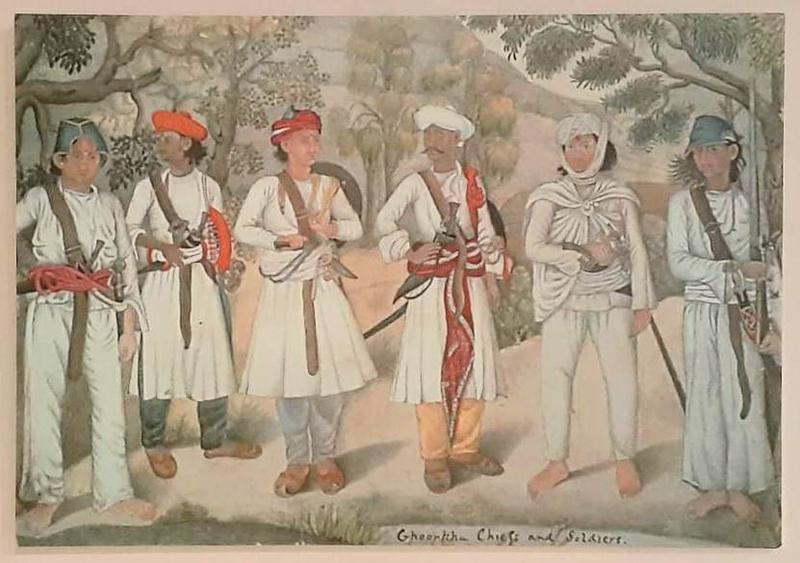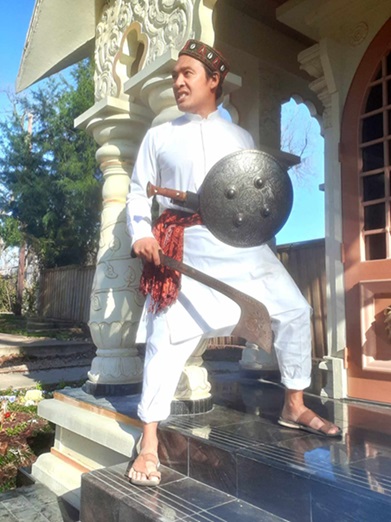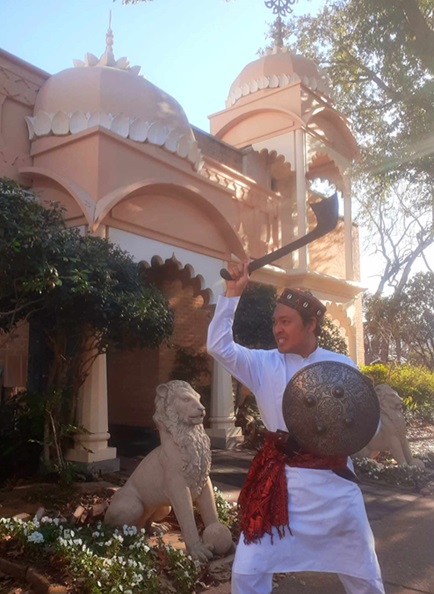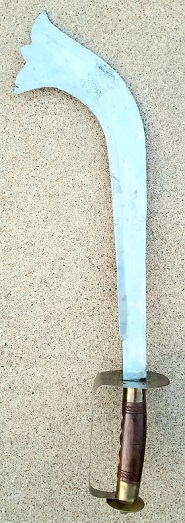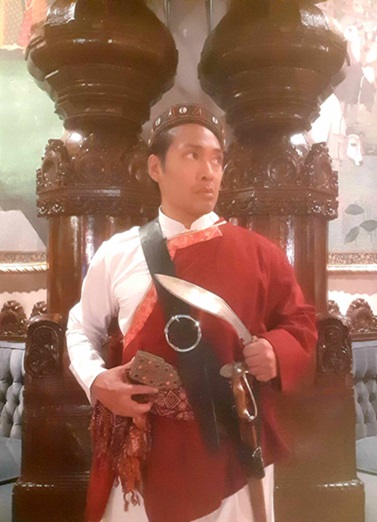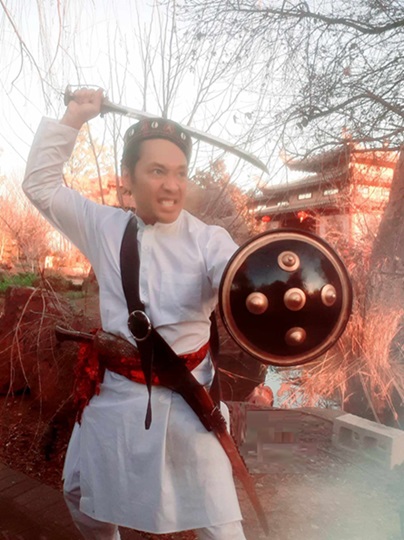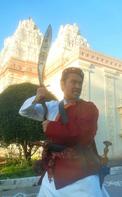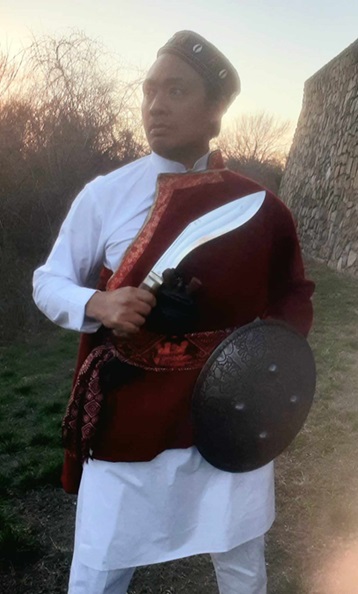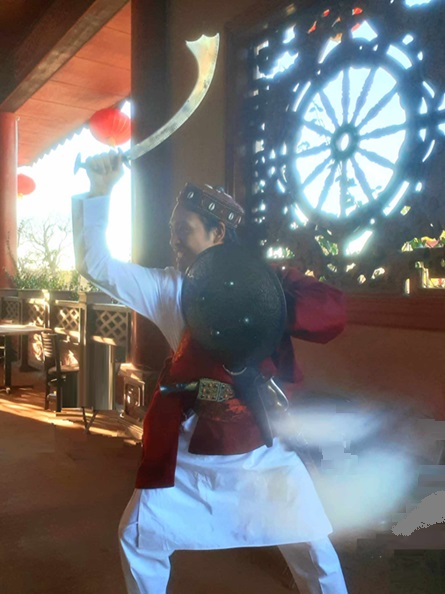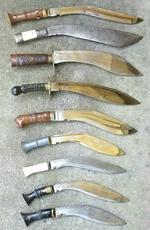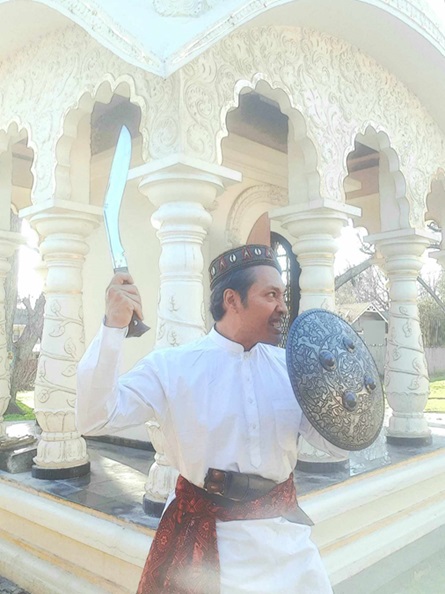Subject: गोर्खा gurkha infantry warrior
Culture: Nepali
Setting: Gurkha empire, Nepal 1768-1816
Context (Event Photos, Primary Sources, Secondary Sources, Field Notes)
* Farwell 1984 p27-28
"The history of Nepal until quite recently has been a long, sad tale of brutality, greed, cruelty, betrayal, barbarity, treachery, rebellion and assassination. Public affairs were conducted with the aid of intrigues, torture, bribery, intimidation and other unsavoury techniques; plots and conspiracies were part of everyday life. Lawrence Oliphant, a nineteenth-century resident of Katmandu, once remarked that 'if you do not associate with assassins, you must give up the pleasures of Nepal society'. Sir Francis Tuker later wrote: 'It is hardly possible for those who have been brought up in the belief that murder is a deadly sin ... to have any but the dimmest understanding of a society, a circle, a community in which to murder makes no impress whatsoever on the conscience of the being who commits it, who abets it or who orders it.'
"The concept of Nepal as a nation is a recent one. For most of its history it has consisted of dozens of tribes and petty kingdoms. Even the Katmandu Valley possessed three tiny monarchies in its 205 square miles. In the hills to the north-west of this valley was a tiny state called Gorkha where in 1742 a man named Prithwi Narayan became king. Colin Simpson, a modern Australian writer, has described him as 'a hillbilly Napoleon, a savage in silk pants'. Ambitious and ruthless, he conquered the petty kingdoms of the Katmandu Valley and before he died in 1774 he laid the foundations of the present state. In the process he did such things as promising the townspeople of Kirtipur that they could surrender to him without fear of retribution, then cutting off the lips and noses of all males over the age of twelve. Only flute-players were exempt. The present king is a direct descendant of Prithwi Narayan, whose statue stands in Katmandu -- noble founder of the nation.
"Prithwi Narayan's successors continued to conquer neighbouring states, even taking in the present-day Indian provinces of Garhwal and Kumaon, and what later became the Simla hill states. Before the end of the eighteenth century these warlike people had reached the zenith of their power and were rubbing the edges of territory conquered by another warlike people: the British."
* Schmidt 1995 p138
"The founder of modern Nepal was Prithvi Narayan Shah (r. 1742-75), the Rajput king of Gorkha, a state sixty-five kilometers (forty miles) west of Kathmandu. After ascending the throne, Prithvi Narayan Shah devised plans for unifying Nepal under his rule. He first reorganized his troops according to British military methods in use at the time, and then acquired control over the northern and southern trade routes leading into the Nepal valley. Both the British in India and the Tibetans, who shared an interest in expanding trade between them, grew concerned by Prithvi Narayan Shah's conquests. In 1767, the British sent troops into Nepal to reopen the trade routes, but neglected to take account of the monsoon, and the mission failed. Meanwhile, Prithvi Narayan Shah's economic stranglehold seriously weakened Malla rule, and in 1769, when Gorkha troops entered the Malla kingdom, it quickly disintegrated.
"Following the collapse of the Malla kingdom, Prithvi Narayan Shah moved quickly to consolidate and improve his position in Nepal, a task which still lay incomplete in 1775, when he died. Prithvi Narayan Shah's successors shared his vision of a unified state, and within fifteen years Gorkha troops had conquered other areas in Nepal, bringing the whole country, from Sikkim to Karnali, under Gorkha rule. Nepal's unification was complete."
Axe
* Rawson 1968 p53
"The Kora is probably the old sword of the Gurkhas and it may well be that their phenomenal military success was largely due to their possession of such a terribly effective weapon. The form of its blade with its forward-sweeping curve and massive tip has affinities with the weapons of other East Indian hill peoples, such as the Daos of the Garos and the Mikirs of Assam. The Kora is, however ,descended indirectly from a very sharply angled version of the forward-angled sword, similar to the versions illustrated at Barabadur, at Khiching and on the Begur stone. This fact suggests an early medieval date, perhaps ninth or tenth century, for its establishment among the hill people. The continuous forward curve and the sharpened top edges were no doubt imparted to it in the course of its development in their hands."
* Withers 2008 p95
"Nepalese edged weapons were strongly influenced by the medieval Indian Rajputs, who brought Indian weapons styles into the region. Alongside the legendary kukri knife (a heavily curved tool and weapon), the kora is the traditional weapon of the Gurkhas (from Nepal and northern India). Its simple all-metal design comprises a wide and heavy blade with a massive flared tip. The grip was tubular, incuding a thin, disc-shaped pommel and cross guard. Decoration of koras includes chiselling and mounting of precious metals to the hilt."
* Stone 1934 p374
"KORA, CORA, KHORA. The national sword of Nepal. It has a very heavy, single-edged blade much incurved and widening greatly at the end, which usually terminates in two concave curves. There is always an eye, or other Buddhistic symbol, inlaid on each side. The scabbards are of two kinds. The commoner is a wide sheath into which the blade can be slipped; the other is shaped to fit the blade and buttons down the back. It is sharp on the concave side."
* Fryer 1969 p87
"Kora The Nepalese national sword. It has a heavy curved single-edged blade with pronounced widening at the end, which is engraved with a Buddhist symbol, often an eye."
* Egerton 1968 p100
"The Nepalese use a larger knife, or sword 'Kora,' with an inner cutting edge, with which those who use it skillfully are enabled to cut a sheep in two at a single blow. ... Their swords and sacrificial axes are generally inscribed at the end of the blade, with Buddhist symbols the use of which seems to extend to Bengal."
* Paul 1995 p63-64
"The kora is the historical war weapon of the Gurkhas and has been in use for centuries. The blade, although longer than that of a kukhri, is still short, measuring about 60 centimetres. It is single edged, narrow at the root, curves sharply forward and widens abruptly to about 9 to 12 centimetres near the massive tip. The weight is clearly at the tip and imparts great force to a swung blow.
"The hilt is always simple with a straight grip and a circular plate of metal below it to serve as a guard and another plate of the same size above it as a pommel, above which is a domed cap enclosing the spiked tang.
"The sheath may be of two types. One is a broad sheath into which the tip can be fitted and the second is shaped like the blade which, therefore, has to be housed from the back of the sheath and buttoned down."
" ... At most, koras have gilded rims to the guard, pommel plates and lac filled lotus symbols on its blade."
* Tarassuk/Blair 1979 p299
"kora The national sword of the Gurkhas of Nepal, probably established in the 9th or 10th century and possibly descended from the kopis. It is an extraordinarily effective weapon that has played an important part in the military successes of these proud hill people. The kora's heavy, single-edged blade is about 60 cm. (24 in.) long, strongly inward-curving, and usually terminating in two concave cuts in the very broad end. Near the lower tip is a black-filled, engraved pattern of a lotus flower enclosed in a circle -- a Buddhist symbol (like the notch in the blade of the kukri) -- with ornamentation along the back edge of each face. The steel hilt, which sometimes incorporates brass elements, consists of a grip between two discs, that is, the guard and the pommel, which is usually topped with a dome and, frequently, a decorative knob.
"The kora scabbard is of two kinds, the more common one being a wide sheath into which the blade can be slipped. The second type is shaped with a wide end to fit the blade and fastens with buttons along the back. These leather scabbards are sometimes covered with velvet, which may be embroidered with silk or furnished with silver mounts."
Saber
* Fryer 1969 p89
"Tulwar The Indian curved sword. The hilt usually has a knuckle-bow and has a disc pommel, and is frequently damascened. The blade is single-edged and often of finely watered steel."
* Wilkinson 1978 p140
"Swords are usually known as talwars although there are many variant forms. The commonest type of talwar had a single-edged blade which usually curved slightly backwards. The hilt was very simple in style with a large plate-like pommel, a slightly swelling metal grip, two very stubby quillons and on many a knuckle bow which curved up from the lower quillon to touch the disc pommel. Often the hilts were decorated with gold or silver and on many the pommel was chiselled as well. Most talwars had two short langets projecting down from the quillons and these gripped the neck of the wooden, leather or velvet-covered scabbard. It is of interest to note that these Indian weapons had grips which are normally a little too small for the hand of the European soldier. [CRITICAL THINKING QUESTIONS: Is there really a significant difference in these hand sizes? Who actually took these measurements?]
"Skill with the talwar or any other form of sword was greatly valued by the Indian warrior and their use was taught at akharas which were the equivalent of the European schools of fencing. These schools continued to teach until well into this century when they were still quite common. The shape of the hilt was, according to one writer, ideal for allowing a firm grip whilst still allowing manoeuvering, when even a small movement of the wrist could give a good slash. It was said that an expert Indian swordsman could stand with one knee against a tree and swing the sword backwards and forwards between him and the trunk without once touching it. The talwars were very sharp and contemporary accounts of the many Indian battles tell many harrowing stories of their terrible effects."
Knife
* Egerton 1968 p100
"The Gorhkas claim to belong to the Kshatri or warrior class, and therefore to the ancient military division of Hinduism. They are a warlike race, and, as already remarked, made a determined resistance to our [British] arms, but now form some of the best of our native infantry. Their national weapon is the Kukri, originally a kind of bill-hook, for cutting through small wood in the dense low jungles of the Terai and the Himalayas. The Gorkha Kukri is generally ornamented with Aryan designs and sometimes even bears the figure of a Hindu deity inlaid in gold on the blade."
* Rawson 1968 p52-53
"Members of all classes of society in Nepal owned and always carried a Kukri in a belted sheath which contained as well one or more small knives, and often a purse holding flint and steel for making fire. The quality and richness of the sheath and its trappings, often very fine, show the wealth of the owner. The Kukris, however, was fundamentally an implement for cutting through the dense forest of the Terai and the Himalayan slopes, and this purpose it never ceased to serve, so that no matter how ornate its trappings, the implement itself retained its functional form and utilitarian qualities. The ridge-ring and band invariably found on the hilt look very much like survivals of what were once functional features at an earlier stage of development, when the tang of the hafting was secured into the handle with a plaited cane band and an iron ring, which have survived as reinforcements to the grip, fitting between the fingers."
* Stone 1934 p397-399
"KUKRI, COOKRI, KOOKERI. The national knife and principal weapon of the Gurkas of Nepal. It has a heavy, curved, single-edged blade sharp on the concave side. The hilt is usually straight and without a guard; occasionally it has a disk guard and pommel like the sword (kora) from the same region. It is carried in a leather sheath with two small knives and a leather pouch. The small knives are shaped like the kukri, though one is often without an edge and is said to have been used for a sharpener. Quite often one, or both, of these knives have hilts of branching staghorn. The weight of the blade of the kukri is well towards the point and a tremendous blow can be struck with it with very little muscular exertion. There are well authenticated instances of a Gurka having split the head of a man and cut well down into his chest with a single blow. It is carried by the Gurkas at all times and is used as a jungle and hunting knife as well as for war. The scabbards are often embroidered with quills or decorated with silver or gold chapes."
* Paul 1995 p62-63
"The kukhri has a short, heavy, forward angled blade which broadens towards the tip. The length of the blade is only about 35 to 40 centimetres but it is heavier towards the point which adds to the effectiveness of the blow.
"[...] The sheaths of kukhris shaped implements are also decorated with big chapes and lockets of gold and silver worked in [r]epousse or filligree [sic]. A smaller sheath is affixed to the back of the larger sheath in which two smaller kukhri shaped implements are housed -- a blunt sharpening steel and a small skinning knife.
"The kukhri is not only a weapon but is also used as an implement for cutting through the thick jungles of the Terai and the Himalayan slopes. It has therefore always retained its functional and utilitarian character.
"It is maintained that a Gurkha never sheaths his kukhri without first drawing blood with it, and most Gurkhas still swear by this custom even today."
* Tarassuk/Blair 1979 p303-304
"kukri (or khukari) The national knife and principal weapon of the Gurkhas of Nepal. Its form, especially the forward-angled blade, shows that it is closely related to the ancient Greek swords machaira and kopis, which almost certainly accompanied Alexander the Great to India. It is not very different from the Indian sosun pattah[,] a version of the Turkish yatagan.
"The kukri is highly regarded by all classes of Nepalese society; its quality and decoration indicate the wealth of the owner. It is carried in a belted sheath containing one or two small knives of kukri shape and, at one time, a purse holding flint and steel for making fire. The kukri is also a useful implement for cutting through dense jungle, but above all it is a formidable weapon, mostly on account of its shape. Its blade is heavy, curved, single-edged, and sharp on the concave side. The weight of the blade is toward the point, and a tremendous blow can be struck using little muscular exertion. The base of the edge of a kukri blade contains a semicircular notch, which, like the lotus blade of the kora, represents the female genital organ, intended to render the blade 'effective.'
"The kukri hilt is usually made of dark wood or ivory; it is straight and has no guard; occasionally it has a disc pommel and a guard (like the kora) and often a ridge ring in the middle -- a survival of the earlier handle with a plaited can band and iron ring. Kukri sheaths, usually mde of velvet-covered wood, are very ornate, embroidered or furnished with embossed and pierced mounts of silver or gold. Kukri belts match the decoration of the sheaths."
* Elgood 2004 p253
"Kukrī (Hindī) Gurkha knife from Nepal with a heavy, single-edged kopis blade, widening towards the point. 'The kookree is a semicircular, long, heavy knife, always carried by the Ghoorkas; sometimes the sheath is curiously embroidered with strips from the quill of the peacock's feather: two small crooked knives are generally in the sheath. The kookree is used for war as well as for all domestic purposes.'" [reference omitted]
* Stone 1934 p366
"The best slashing knife is the Gurka kukri, a blow of which can split a man to the waist."
* Fryer 1969 p87
"Kukri The Gurkha knife, with heavy, single-edged blade, very sharp on the inner edge. There is a small semicircular depression near the hilt which is a phallic symbol having religious significance. The guardless hilt is usually of horn or ivory and sometimes of engraved steel of silver. The sheath is fitted with two small companion knives of similar shape, but may even have an assortment of accessories."
* Rawson 1968 p14
"Kukris are generally more ornate [than Koras], having round their hilts bands of carved foliate ornament, sometimes in very deep relief and undercut. The root of the edge of a Kukri blade contains a semicircular nick about three-quarters of an inch deep, generally with a tooth at the bottom, which like the lotus on the blade of the Kora, the Gurkhas say represents the female generative organ, intended presumably to render the blade 'effective'. The sheaths of Kukris are frequently adorned with a scroll pattern in a band stitched in peacock quills, and bear big chapes and lockets of gold or silver or silver-gilt, worked in repouseé or filligree [sic], or chiselled, with great skill. The ornamental designs, though often beautifully cut, are limited in form to floral scrolls, and one instance differs from another only in the degree of elaboration of the work. The style of the ornament is distinctively Indian, probably Rajput, in origin.
"Many of the small Kukri knives carried in the sheaths of Kukris have their pommels carved into the form of lion-heads. It is not possible at present to say when or how this feature originated."
Dagger
*
"
Costume
*
"
Bottle
*
"
